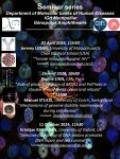There is strong evidence for a relationship between the topological properties of chromatin contacts and cellular phenotype.
Chromatin can be represented as a network, in which genomic fragments are the nodes and connections represent experimentally observed spatial proximity of two genomically distant regions. With this approach we have considered a variety of chromatin features in association with the 3D structure. Using tools that we have generated to facilitate the global statistical analysis of these integrated 3D epigenomes, we have started investigating how nuclear chromatin organization can be related to gene regulation, replication, malignancy, phenotypic variability and plasticity.
We are particularly interested in understanding how epigenomic characteristics of immune cells are shaped through differentiation and in the presence of different stimuli and how they can impact their behaviour in diseases, including cancer, in which they are determinant factors in therapy response.
References:
1) Using GARDEN-NET and ChAseR to explore human haematopoietic 3D chromatin interaction networks.
Madrid-Mencía M, Raineri E, Cao TBN, Pancaldi V.Nucleic Acids Res. 2020 May 7;48(8):4066-4080. doi: 10.1093/nar/gkaa159.
2) Three-dimensional connectivity and chromatin environment mediate the activation efficiency of mammalian DNA replication origins
Karolina Jodkowska, Vera Pancaldi,et al. bioRxiv 644971; doi: https://doi.org/10.1101/644971
https://umontpellier-fr.zoom.us/j/88189136799?pwd=SmVCSGozVWtXWTAxNkZyYWNkSGttUT09
Meeting ID: 881 8913 6799
Passcode: Pancaldi




